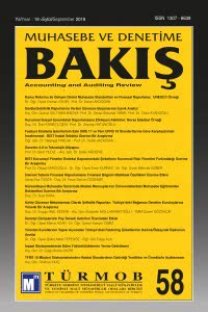SERBEST MUHASEBECİ VE SERBEST MUHASEBECİ MALİ MÜŞAVİRLERİN İŞ TATMİNİ DÜZEYLERİNİN BELİRLENMESİNE YÖNELİK BİR ARAŞTIRMA: ORTAve DOĞU KARADENİZ BÖLGELERİ ÖRNEĞİ
Bu çalışmanın amacı Serbest Muhasebeci ve Serbest Muhasebeci Mali Müşavirlerin iş tatmini düzeylerini belirlemektir. Çalışmanın amacını gerçekleştirmek için Türkiye Serbest Muhasebeci Mali Müşavirler ve YeminliMali Müşavirler Odalar Birliği’ne TÜRMOB kayıtlı ve Orta ve Doğu Karadeniz Bölgelerinde faaliyet gösteren meslek mensuplarına Appleton v.d. 1998 tarafından geliştirilmiş anket formu yöneltilmiştir. Sonuçlar SPSS13 paket programı aracılığı ile frekans ve tek yönlü ANOVA analizlerine tabi tutulmuştur. Sonuç olarak Orta veDoğu Karadeniz Bölgelerinde faaliyet gösteren Serbest Muhasebeci ve Serbest Muhasebeci Mali Müşavirlerinmesleklerinin iş tatmini boyutlarından düşük düzeyde tatmin elde ettikleri tespit edilmiştir. Bu çalışma, SerbestMuhasebeci ve Serbest Muhasebeci Mali Müşavirlik mesleklerinin çevresinde bulunan bireyler, odalar ve düzenleyici kurumların meslek mensuplarının sosyal ve psikolojik yönelimlerini daha fazla dikkate alması gerektiğini savunmaktadır
Anahtar Kelimeler:
İş tatmini, muhasebeciler, muhasebe mesleği
AN EMPIRICALANALYSIS OF THE TURKISH CERTIFIED PUBLIC ACCOUNTANTS’ JOB SATISFACTION: MIDDLE & EASTERN BLACKSEA REGIONS EXEMPLIFICATION
This study aims to determine job satisfaction of the professional accountants in Middle and Eastern BlackseaRegions of Turkiye. Appleton et al. 1998 ’s questionary was applied to Certified Public Accountants from Union of Chambers of Certified Public Accountants of Turkiye TÜRMOB registered 6 Eastern Blacksea Regionchambers Trabzon, Giresun, Ordu, Rize, Gümüşhane and Samsun . SPSS 13 packaged software is used in data entrance-analyze, descriptive statistics and one-way ANOVA analysis processes. Total job satisfaction scoresshow that certified public accountants in Middle and Eastern Blacksea Regions of Turkiye are not being satisfied with the professional dimensions of job satisfaction.Thus this paper suggests that the profession regulators inTurkiye should seriously pay attention to social and psychologic problems of the accountants
Keywords:
Job Satisfaction, accountants, accounting profession,
___
- Akıncı, Z. (2002). ?Turizm Sektöründe İşgören İş Tatminini Etkileyen Faktörler: Beş Yıldızlı Konaklama İşlet- melerinde Bir Uygulama”, Akdeniz İ.İ.B.F. Dergisi, (4), ss.1-25.
- Appleton, K., House, A. ve Dowell, A. (1998). “A Survey of Job Satisfaction, Sources of Stres and Psychologi- cal Sysmptoms Among General Practitioners in Leeds”, British Journal of General Practice, March, ss.1059
- Bakan, İ. ve Büyükbeşe, T. (2004). “Örgütsel İletişim İle İş Tatmini Unsurları Arasındaki İlişkiler: Akademik Ör- gütler İçin Bir Alan Araştırması”, Akdeniz İ.İ.B.F. Dergisi, (7), ss.1-30.
- Bauer, T.K. (2004). High performance workplace practices and job satisfaction: Evidence from Europe, Discus- sion Paper No.1265, Institute for the Study of Labour (IZA), http://ftp.iza.org/dp1265.pdf
- Chou, S.C., Boldy, D.P. ve Lee, A.H. (2002). “Measuring job satisfaction in residential aged care”, Internatio- nal Journal of Quality in Health Care, Vol.14, Number:1, ss.49-54.
- Clark, A., Oswald, A. ve Warr, P. (1996). “Is job satisfaction U-shaped in age?”, Journal of Occupational and Organtzaional Psychology, 69, ss. 57-81, içinde: The British Psychological Society, Great Britain
- Clark, A.E. (1998). Measures of job satisfaction - What makes a good job? Evidence from OECD countri- es, Labour Market and Social Policy - Occasional Paper No:34, OECD, Paris.
- Çolakoğlu, G. (2007). Muhasebecilerin Rüyaları, Karadeniz Gazetesi http://www.karadenizgazete.com.tr/kose.php?id=7219, erişim: 06.02.2007
- Davis, J. ve Wilson, S.M. (2000). “Principals’ Efforts to Empower Teachers: Effects on Teacher Motivation and Job Satisfaction and Stres”, The Clearing House, 73 (6), ss. 349-353.
- De Nobile, J. (2003). Organisational Communication, Job Satisfaction and Occupational Stress in Catholic Pri- mary Schools. Unpublished doctoral thesis, University of New South Wales, Sydney.
- Dinham, S. ve Scott, C. (2000). “Moving Into the Third, Outer Domain of Teacher Satisfaction” Journal of Edu- cational Administration, 38 (4), ss.379-396.
- Erdoğan, İ. (1994). İşletmelerde Davranış, Beta Basım Yayım, İstanbul.
- Eurofound (European Foundation for the Improvement of Living and Working Conditions) (2006). Measuring job satisfaction in surveys - Comparative analytical report, İrlanda.
- Furnham, A. (1997). The Psychology of Behaviour at Work. Hove: Psychology Press.
- Handyside, J.D. (1961). “Satisfactions and aspirations”, Occupational Psychology, 35, ss.213-243.
- Iverson, R.D. ve Maguire, C. (2000). “The Relationship Between Job and Life Satisfaction”, Human Relati- ons, 53(6), ss. 807-839.
- Janson, P. ve Martin, J.K. (1982). “Job satisfaction and age: A test of two views”, Social Forces, 60, ss.1089
- Miner, J.B. (1992). Industrial- Organizational Psychology, McGraw-Hill Int, Singapore.
- McCormick, J. (1997). “An Attribution Model of Teachers’ Occupational Stress and Job
- Satisfaction in a Large Educational System”, Work and Stress, 11 (1), ss.17-32. Ngo, C. ve Sansgiry, S.S. (2004). “Job satisfaction of pharmacists at a large medical Center”, Am J Health-Syst Pharm, Vol 61, Feb 15, ss.405-406
- Özgen, H., Öztürk, A. ve Yalçın, A. (2002). İnsan KaynaklarıYönetimi, Nobel Kitabevi, Adana.
- Rice, R.W., Gentile, D.A., ve McFarlin, D.B. (1991). “Facet Importance and Job Satisfaction”, Journal of App- lied Psychology, 76, ss.31-39.
- Rose, M. (2001). Disparate measures in the workplace...Quantifying overall job satisfaction , Paper presented at the 2001 BHPS Research Conference, Colchester, available at: http://www.iser.essex.ac.uk/bhps/2001/docs/pdf/papers/rose.pdf
- Sousa-Poza, A. ve Sousa-Poza, A.A. (2000). “Well-being at work: a cross-national analysis of the levels and de- terminants of job satisfaction”, Journal of Socio-Economics , Vol. 29, No. 6, ss. 517-538.
- Spector, P.E., (1997). Job satisfaction: Application, assessment, causes, and consequences, Sage, London.
- Warr, P.B. (1992). “Age and occupational well-being”, Psychology and Aging, 7, ss. 37-45.
- Weaver, C.N. (1980). “Job satisfaction in the United States”, Journal of Applied Psychology, 65, ss.364-367.
- Woods, A.M. and Weasmer, J. (2004). “Maintaining Job Satisfaction: Engaging Professionals as Active Participants”, Clearing House, 77 (3), ss.118-136.
- Yereli, A.B. (2006). Muhasebe Meslek Mensupları Anketi: Mesleki Profil, Sorunlar, Çözüm Önerileri (1.8.2006) http://www.alomaliye.com/agustos_06/muhmeslek.htm
- ISSN: 1307-6639
- Yayın Aralığı: Yılda 3 Sayı
- Başlangıç: 2000
- Yayıncı: TÜRMOB
Sayıdaki Diğer Makaleler
NIFO STOK DEĞERLEME YÖNTEMİNİN FAALİYET SONUÇLARI ÜZERİNDEKİ ETKİLERİ
MUHASEBE MESLEK MENSUPLARININ MESLEKİ FAALİYETLERE İLİŞKİN ANKET SONUÇLARININ DEĞERLENDİRİLMESİ
MUHASEBE BİLGİ SİSTEMLERİNİN RİSK YÖNETİMİNE YÖNELİK BİR
ŞİRKETLERİN YÖNETİMİNDE TEMSİL SORUNU VE KURUMSALYÖNETİM
UFRS TFRS ’DEKİ DEĞERLEME ÖLÇÜLERİ KAPSAMINDAŞİRKET DEĞERLEMESİNDE DEFTER DEĞERİ YAKLAŞIMI
